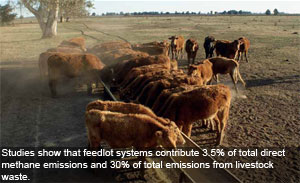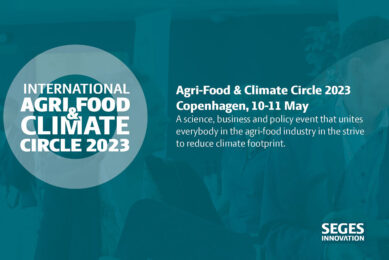Greenhouse gas reduction via nutrition

Attempts are being made through dietary manipulation to mitigate greenhousegas emissions without altering animal performance. Possible strategies werediscussed at the British Society of Animal Production annual meeting in 2009. naheeda portocarero presents an overview.
By Naheeda Portocarero
Reducing, or mitigating greenhouse gases (GHG) from livestock systems can play a vital role in providing solutions to climate change obligations. Gut fermentation in ruminants is an important source of methane production – in the UK ruminants contribute approximately 20% of all methane emissions, with most arising from cattle. Furthermore, ruminants lose around 8 to 12% of their food energy as methane, and therefore reducing methane production can be of direct economic benefit. The main options available to the livestock sector, outside of grazing management, are through the efficiencies with which ruminants utilise their diet and through manure management.
A typical Australian beef-lot system
Feedlot management systems for beef cattle are becoming more common in some countries despite having been identified as point sources of greenhouse gas emissions (methane, nitrous oxide and the indirect greenhouse gas, ammonia). Alford et al(2006) estimated that feedlot systems contribute 3.5% of total direct methane emissions and 30% of total emissions from livestock waste. A review by Bai and co-workers from the Universities of Melbourne and Wollongong in Australia quantified the methane, nitrous oxide and ammonia emissions from an Australian feedlot system managed under summerclimatic conditions, comparing actual emissions with those estimated from three recognised models. The feedlot was in Victoria and was representative of a typical operation in South-East Australia, with a capacity of 12,800 cattle of mixed genotype reared from approximately 200 to 600 kg. The diets offered consisted of barley and wheat grain, grass silage, grass hay, whole cotton seed, bread waste, molasses and vegetable oil supplements.
Data collected were used to measure enteric methane using IPCC 1996 Tier II (3% GEI), Blaxter and Clapperton (B&C, 1965) and Moe and Tyrell (M&T, 1979). Methane emissions from manure were estimated using volatile solids and a methane conversion factor of 1.5% (relevant for temperate regions). Emissions of nitrous oxide and ammonia from manure were estimated using emission factors of 0.02 and 0.3 of manure nitrogen respectively. The measured total nitrous oxide was adjusted for direct (animal) emissions. Carbon dioxide emission was calculated using a value of 21 for CH4 and 310 for N20 (Table 1). The emissions measured from the feedlot were comparable to calorimetric studies with beef cattle in North America and Canada (Moe and Tyrell, 1979).
The authors concluded that the equation currently used in the Australian Methodology (M&T) provides the best estimate of feedlot methane production. Approximately 185g of methane, 8g of nitrous oxide and 112 g of ammonia per head per day were measured.
Immediate methane reductions
While manure management strategies have been proposed as a possibility to partly reduce greenhouse gas output, nutritional strategies also play a promising role. Most of the work to date has looked at dairy cow nutrition. One promising possibility is to change the dietary fat supply. Experiments by Martin et al from INRA, France showed that increasing extruded linseed supply in a hay-based or maize silage-based diet resulted in methane reduction of up to 200 litres per cow per day (p<0.05). The higher the level of linseed, the greater the reduction. There were no changes in dry matter intake or milk yield.
Extruded linseed
The reduction was seen at levels of 10% and 15% linseed with a hay diet and for 15% linseed with a maize silage diet. The extent of the decrease was 15, 19 and 40% in experiment 1, and 6, 13 and 42% in experiment 2 for a supply of 5, 10 and 15% extruded linseed, respectively. These experiments show that a dietary supply of extruded linseed decreases methane production both with hay and maize silage diets, without altering milk yield.
The extent of the decrease depends on the dietary linseed content. The use of linseed is one of the most efficient methods yet studied to mitigate methane emissions.
Protein and concentrate feeding
Altering protein concentration has also been proposed as a means of mitigating methane. Researchers Tan and co-workers from the Agri -Food and Biosciences Institute in the UK found that increasing dietary crude protein concentration from 120 to 150 g/kg DM in dairy cows significantly reduced methane emission as a proportion of dry matter intake and milk yield. Further increasing dietary crude protein concentration to 180 g/kg DM had no effect (Table 2). This group of researchers also looked at the effect of concentrate feeding on methane emission of Holstein and Holstein Jersey dairy cows. Eight Holstein and eight Jersey-Holstein first lactation cows were used in a 4 period (6 weeks/period) changeover study. Total methane output and methane output per milk yield were higher with Jersey Holstein cows (P<0.01), although results showed that cross breeding had little effect on proportional methane production. Increasing dietary concentrate level reduced methane emission as a proportion of feed intake and milk yield.
Spicing up the diet
It has been shown that tannin and unsaturated fatty acid can play important roles to reduce methane production in ruminants (Patra et al, 2006; Giger-Reverdin et al,2003). Some spices are high in tannin and others are high in fatty acids.
Therefore, researchers Khan and Chaudhry from Newcastle University looked at the chemical composition of a range of five spices and assessed their ability to reduce methane production in vitro. Ground wheat, a highly fermentable feed which can produce a large volume of gas, was used as the substrate and the spices were added at a fixed level of 30 mg/g wheat.
Methane production was highest in the control (wheat only) diet. The order of ability of spices to reduce methane production was coriander (strongest ability to reduce methane production), turmeric, cloves/ cumin, cinnamon (least ability to reduce methane production). The authors proposed that careful selection and manipulation of these spices may allow us to manipulate rumen degradation and reduce methane output. Another proposal to reduce methane has been the use of fish oil; however the work of Petri et alfrom University College Dublin, Ireland found that while inclusion of 2% fish oil resulted in decreased methane production (p<0.05) this was associated with a linear reduction in feed intake (p=0.001).
Cost effectiveness of strategies
A study has been undertaken at SAC Edinburgh by Wall and co-workers to look at the cost effectiveness of selected management options for the UK livestock sector. Table 3shows a range of animal and manure management options which are currently feasible in the UK and that have a high potential for the abatement of greenhouse gases from livestock systems.
Some of the measures proved to be highly cost-effective such that adopting it would result in a cost-saving to the farming system. For example, the use of recording and genetic selection tools for beef would result in economic improvements. Improving the uptake of such tools and increasing the efficiency of production in some beef systems will not only have a large impact on overall GHG emissions but will also have an impact on the overall farm profit and sustainability and therefore be highly cost-effective.
Source: FeedMix vol 17 nr 6, 2009











